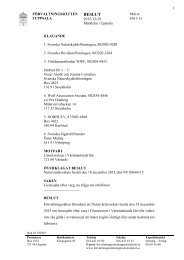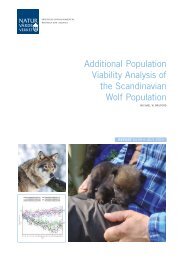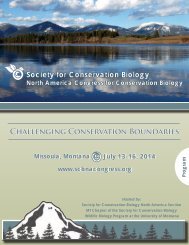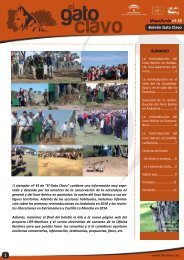1oC3Dbk
1oC3Dbk
1oC3Dbk
Create successful ePaper yourself
Turn your PDF publications into a flip-book with our unique Google optimized e-Paper software.
The major task for the group in 2014 is the re-assessment<br />
of the conservation status of the four species of sirenia for The<br />
IUCN Red List of Threatened Species.<br />
Helene Marsh, Benjamin Morales<br />
Co-chairs, Sirenia Specialist Group<br />
Small Carnivore Specialist Group (SCSG)<br />
Small carnivores represent over half of all species in the order<br />
Carnivora. This diverse group includes over 150 species in<br />
nine families (Ailuridae, Eupleridae, Herpestidae, Mephitidae,<br />
Mustelidae, Nandiniidae, Prionodontidae, Procyonidae, and<br />
Viverridae). A central theme of the SCSG is to improve the<br />
dissemination of information on this incredible group of<br />
species. The goals of the SCSG, as established by IUCN, are<br />
to: 1) Provide leadership for the conservation of all small<br />
carnivore species, 2) Determine and review on a continuing<br />
basis the status and needs of small carnivores, and support<br />
effective research, conservation, and management programs,<br />
and 3) Make known the status and conservation needs of<br />
small carnivores, and promote their wise management.<br />
Two issues of the journal Small Carnivore Conservation<br />
(SCC) were produced; one dedicated to African species<br />
(volume 48) and another focusing globally (volume 47). Both<br />
can be accessed via the journal website. In addition, group<br />
members were convened at a symposium during the 11th<br />
International Mammalogical Congress 2013 (Belfast, Ireland),<br />
entitled “Small Carnivores in Space and Time”. Group<br />
members have been working to produce two published<br />
proceedings; a book resulting from the collection of chapters<br />
presented at the IMC2013 Congress and another proceeding<br />
of the ‘Borneo Conservation Symposium’ from an earlier<br />
conference. Additionally, the SCSG was among the sponsors<br />
of ‘A conference on the biology and conservation of wild<br />
mustelids, skunks, procyonids and Red Panda’ held at the<br />
Department of Zoology, University of Oxford. Finally, several<br />
group members were involved in the description of a new<br />
small carnivore species, the olinguito (Bassaricyon neblina),<br />
the first new mammal species in the order Carnivora described<br />
in the Americas in 35 years.<br />
We are thankful to a great number of donors and<br />
sponsoring organizations, as well as the group itself and to the<br />
journal specifically. We are indebted to the Nature<br />
Conservation Foundation for maintaining the group and journal<br />
website, to the Zoological Society of Southern Africa,<br />
University of Fort Hare and Southern African Wildlife<br />
Management Association for contributions to the Africa<br />
Special Edition of the SCC journal, and to the Houston Zoo,<br />
Greenville Zoo and Missisippi State University (MSU) for<br />
contributions towards the previous SCC issue. We are also<br />
grateful to MSU, Arizona State University, Universidad Nacional<br />
Autónoma de México, and the Sierra to Sea Institute for their<br />
in-kind sponsorship of SCSG chairs.<br />
Jan Schipper and José F. González-Maya<br />
Chair, Small Carnivore Specialist Group<br />
Small Mammal Specialist Group<br />
Formed in 2011, the Small Mammal Specialist Group (SMSG)<br />
is an expanding global network of scientists and<br />
conservationists who specialize in the world’s rodents, shrews,<br />
moles, solenodons, hedgehogs and tree-shrews. Our mission<br />
is to serve as the “global authority on the world’s small<br />
mammals through developing a greater scientific<br />
understanding of their diversity, status and threats, and by<br />
promoting effective conservation action to secure their future”.<br />
Our volunteer members conduct fieldwork and lab research to<br />
improve the world’s scientific understanding of the taxonomy,<br />
ecology and conservation status of over 2,800 of these often<br />
poorly known species. We promote conservation actions on<br />
the ground for species of conservation concern, and develop<br />
strategies to enable more effective conservation of small<br />
mammals.<br />
In 2013, we conducted a global analysis of small mammal<br />
distributions to pinpoint sites and regions around the world that<br />
support globally important small mammal assemblages. This<br />
underpinned a conservation prioritisation process to guide<br />
membership recruitment, and focus our knowledge gathering<br />
for Red Listing and action-planning for conservation. With Dr<br />
Kris Helgen, we completed a rapid taxonomic review of the<br />
rodents, tree-shrews and eulipotyphlan insectivores, listing<br />
around 120 or so species that have been described since 2008<br />
with many other sub-species taxonomic revisions. With the<br />
Global Mammal Assessment Team of Rome’s Sapienza<br />
University, we launched a major project to assess or reassess<br />
the 2,800 small mammal species for The IUCN Red List by end<br />
of 2015. So far, we have completed 50 assessments of new<br />
small mammal species – now on the Global Mammal Forum –<br />
and will have completed roughly 200 species reassessments by<br />
the end of the year. In October, we launched our new website<br />
Olinguito (Bassaricyon neblina). © Miguel Pinto<br />
Hispaniolan Solenodon (Solenodon paradoxus). © Jose Nunez-Mino<br />
82 IUCN species Annual Report 2013






